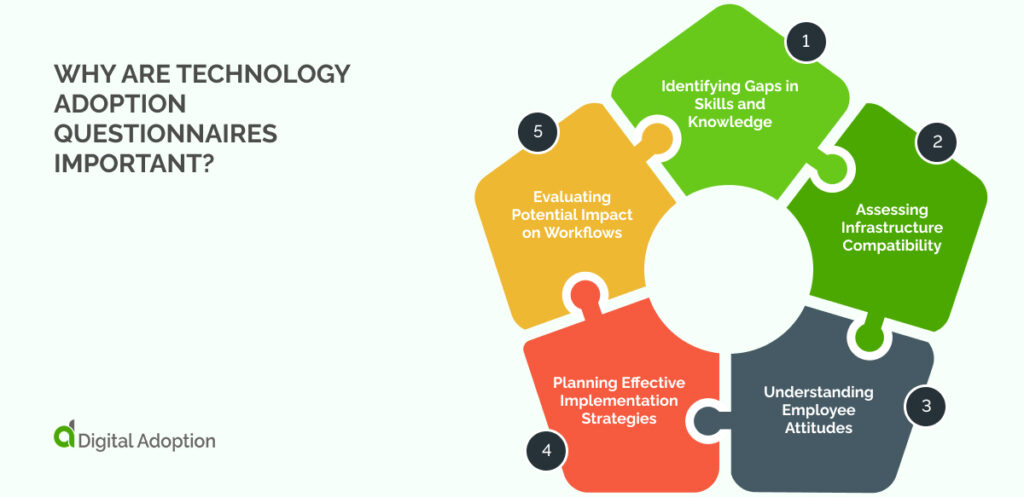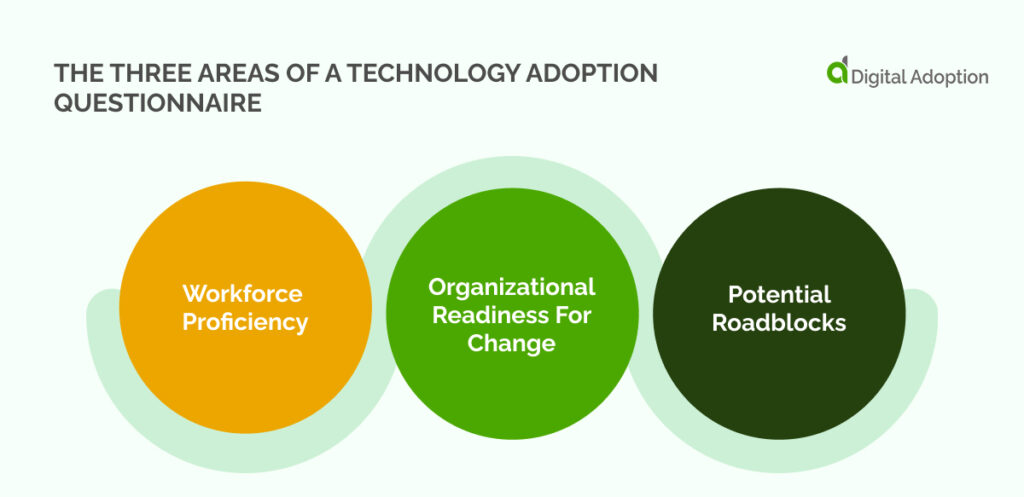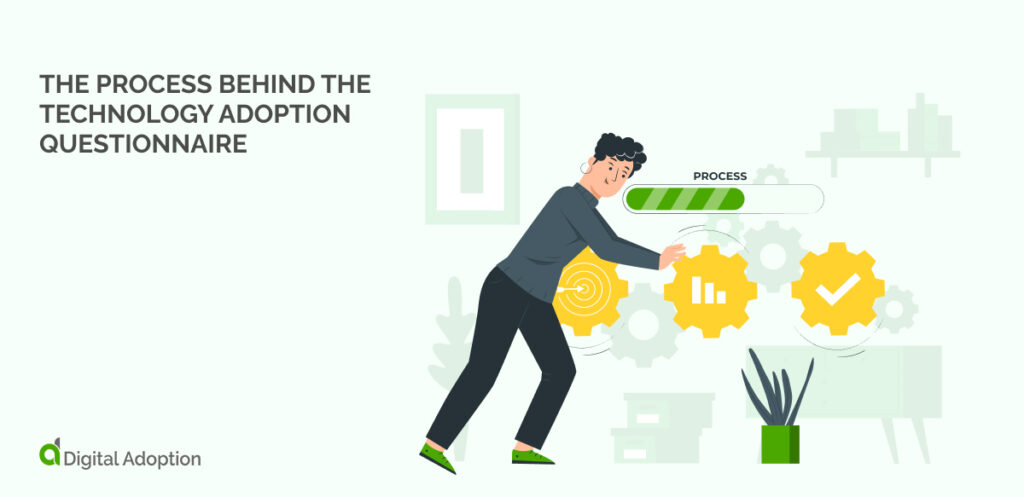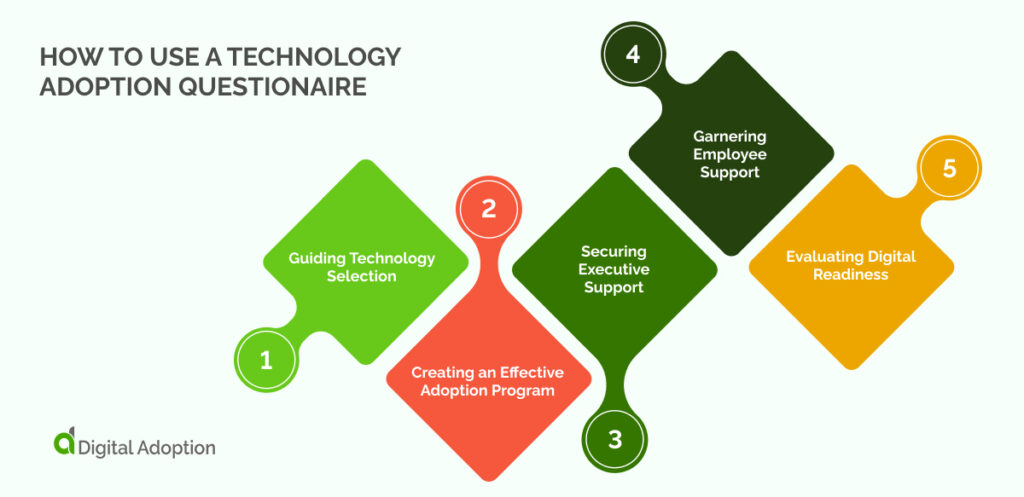
In the rapidly evolving world of technology adoption, businesses are perpetually on the cusp of the next big tech upgrade.
At the heart of every digital transformation lies an essential query: Are the employees equipped to navigate this change? Is the organization itself ready for this shift?

To unravel the answers to these critical questions, businesses turn to a vital resource – the technology adoption questionnaire.
Your technology adoption questionnaire should be meticulously designed to cover three fundamental areas:
It’s not just about asking the right questions but also about framing them in a manner that elicits the most accurate responses.
With these key areas addressed, a technology adoption questionnaire will offer a comprehensive picture of the organization’s readiness for a tech upgrade.
This article will provide all the necessary information on crafting a comprehensive technology adoption questionnaire that yields long-term results.
Table of ContentsA technology adoption questionnaire is a structured tool used by organizations to assess the readiness of their employees and their overall infrastructure to integrate and utilize new technological advancements.
This tool typically comprises a series of questions designed to gauge various aspects such as employee skill levels, the potential impact on workflows, and the compatibility of the new technology with existing systems.
The responses gathered from this questionnaire provide valuable insights that help the organization plan effective strategies for technology implementation, minimizing disruptions and maximizing benefits to the digital employee experience (DEX).
It also aids in identifying potential challenges and barriers to adoption, enabling proactive measures to ensure a smooth transition and optimal utilization of the new technology.

The success of an organization now heavily relies on its ability to embrace and integrate technology.
It enables businesses to streamline operations, improve IT efficiency, and maintain a competitive edge in their respective industries.
However, the seamless integration of new technologies necessitates a thorough understanding of the organization’s readiness, which is where technology adoption questionnaires play a pivotal role.

Before integrating new technology into a business, three critical areas need to be evaluated: Workforce Proficiency, Organizational Readiness for Change, and Potential Roadblocks.
Understanding these aspects can significantly streamline the adoption process, ensuring a smooth transition while minimizing disruption.
Understanding the current proficiency levels of your workforce is crucial when introducing new technology. Start by evaluating their familiarity and comfort with similar technologies. Gauge their ability to adapt to new tools and measure their digital literacy.
This will help you determine the extent of training required for seamless adoption. Additionally, assess their openness to learning new skills. A workforce that’s proficient and eager to adapt is a significant advantage during technology adoption.
Before implementing new technology, assessing the organization’s readiness for change is paramount. Identify the alignment of the new technology with the organization’s strategic objectives. Understand the level of commitment from leadership and their willingness to provide the necessary support.
Assess the current IT infrastructure and its compatibility with the proposed technology. An organization ready for change will have the necessary structures to support the new technology and drive its successful integration.
Identifying potential roadblocks early can mitigate risks associated with technology adoption. These may include employee frustration, lack of technical expertise, or budget constraints. Assessing these challenges beforehand allows for proactive planning and problem-solving.
Also, consider the impact of the new technology on existing workflows and processes. Understanding potential roadblocks helps create a comprehensive strategy for smooth technology adoption and minimizes digital disruption.


Implementing a technology adoption questionnaire starts with identifying the new technology an organization intends to integrate into its operations.
This could range from a software application to an advanced IT infrastructure. Once the technology is identified, a comprehensive questionnaire is developed, tailored specifically to assess readiness and compatibility with the targeted technology.
Each question in the questionnaire should be strategically designed to gather specific data related to the chosen technology. For instance, if the technology is a new project management software, questions may focus on users’ familiarity with similar software, their comfort level with digital tools, and their perceived benefits and challenges of using such an application.
If the technology involves a major IT infrastructure upgrade, questions might delve into the existing system’s capabilities, potential compatibility issues, and the readiness of staff to adapt to significant changes.
This meticulous approach ensures that the questionnaire yields meaningful insights that can guide the successful adoption of the specific technology.

The deployment of the technology adoption questionnaire should ideally coincide with recognizing a specific need or issue within your organization.
Early distribution of the questionnaire allows for swift data lifecycle management, and it also subtly initiates the process of change within the mindset of the employees.
Leveraging digital platforms such as Google Forms to distribute the questionnaire can expedite data-gathering. These platforms facilitate the automatic compilation of responses, making them especially useful for large-scale organizations.
To keep a finger on the pulse of the organization’s evolution, it is advisable to conduct these surveys periodically.
The insights derived from a technology adoption questionnaire can be utilized in several ways:
In any business venture, data is a crucial ingredient for success.
The insights obtained from the technology adoption questionnaire offer a wealth of information that can be utilized in numerous ways to drive successful technology integration.

Crafting a technology adoption questionnaire demands strategic planning and foresight.
It serves as a compass, directing an organization’s journey toward successfully integrating new technology. The questionnaire should cover the organization’s readiness, employees’ comfort level with similar technology, and adaptability to change.
It’s vital to probe potential challenges and benefits, ensuring the chosen technology aligns with the organization’s goals and has the necessary support for effective adoption. Questions aimed at understanding digital maturity, infrastructure compatibility, and security concerns enrich the insights derived from the questionnaire.
This data becomes the linchpin in navigating technology selection, creating impactful training programs, securing leadership backing, and rallying employee support for digital adoption initiatives.
A meticulously designed technology adoption questionnaire transcends its basic function of data collection. It morphs into a strategic tool that drives successful technology integration and fosters a culture of innovation.
With every question, it nudges the organization closer to its future goals, making it an indispensable part of the technological revolution within any organization.